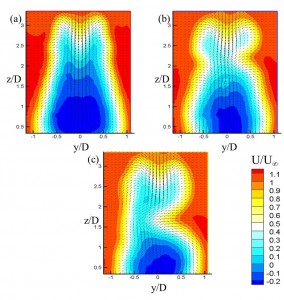Spanwise and circumferential surface pressure measurements were previously made on a finite-span circular cylinder of low-aspect ratio indicating that a large scale global change to the flow field was accomplished due to the action of a single synthetic jet. Due to the cylinder having a finite span, flow over the free-end of the cylinder is drawn to the rear due to the lower pressure on the rear of the cylinder, a result of boundary layer separation. The aforementioned surface pressure measurements were therefore made with and without a top fence placed on the free-end of the cylinder. With the top fence placed on the cylinder, the downwash was displaced three diameters downstream of the cylinder, allowing for pressure measurements to be made without direct interference of the downwash.
With the top fence attached to the cylinder, a symmetric circumferential pressure distribution was attainable at a jet angle of 113º with respect to the free-stream velocity. By removing the top fence, this pressure distribution became largely asymmetric. Consequently, regardless of the presence of the top fence, the pressure measurements indicated a large-scale spanwise change to the surface pressure. This spanwise effect was particularly outstanding considering the size of the jet orifice (1 mm) compared to the span of the cylinder (~300 mm). Therefore, the results of this study indicated that the downwash is a major feature of the wake of a low-aspect ratio finite cylinder, dramatically impairing the ability of the synthetic jet to enact large scale global changes to the flow field.

Figure 1: Finite Span Cylinder

Figure 2: Contours of the out-of-plane velocity component (U-velocity) with in-plane velocity vectors (V, W) for the (a) baseline, (b) jets at 90º with Cb = 0.6, and (c) jets at 113º with Cb = 0.6.